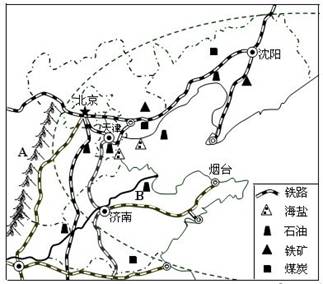继长江三角洲、珠江三角洲两大经济地带之后,我国又一工业密集区——环渤海经济圈已初步形成,它将带动北方地区经济迅速发展。阅读材料回答下列问题。(7分)
材料一: 环渤海经济圈狭义上指辽东半岛、山东半岛和京、津、冀为主的环渤海滨海经济带,可延伸辐射到山西、辽宁、山东全省以及内蒙古的部分地区。以京、津为中心带动的两侧扇形区域已成为中国乃至世界上城市群、工业群、港口群最为密集的区域之一。
材料二: 环渤海地区土地、人口、国民生产总值、水资源约占全国比例表。
| 内容 | 土地 | 人口 | 国民生产总值 | 水资源 |
| 约占全国比例(%) | 5.4 | 17.5 | 26.2 | 3.54 |

(1)山脉A是 ,矿产地B是 。
(2)水资源缺乏是限制环渤海地区经济发展的主要因素之一。请结合材料二分析该地区水资源缺乏的原因 、 。
(3)你认为环渤海地区经济发展的优势条件有哪些?(至少三条)
(共7分)(1)2分,每空1分。太行山 胜利油田 (2)2分。人口众多,工农业发达,需水量大;水资源总量少 (3)3分。矿产资源丰富;交通发达;地理位置优越;劳动力丰富;科技力量雄厚(只要答对三点即可得3分)
题目分析:(1)山脉A是太行山,矿产地B是胜利油田;(2)水资源缺乏是限制环渤海地区经济发展的主要因素之一。该地区水资源缺乏的原因是春季升温但雨季没来,蒸发量大,人口众多,工农业发达,需水量大;水资源总量少;(3)环渤海地区经济发展的优势条件有矿产资源丰富;交通发达;地理位置优越;劳动力丰富;科技力量雄厚。
点评:本题还可以考查我国工业的空间分布:京广、京沪、京哈等铁路沿线有全国意义的工业基地;黄河流域能源工业带;长江沿线经济发达带;沿海四大工业基地以及经济特区和沿海开放城市等工业最发达的经济核心区。我国四大工业基地:①辽中南(重工业为主)、②京津唐(北方最大的综合性工业)、③沪宁杭(历史悠久、基础雄厚、全国最大的综合性工业基地)、④珠江三角洲(轻工业为主);上海——我国最大的工业城市。
